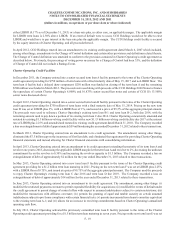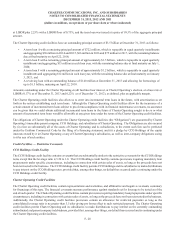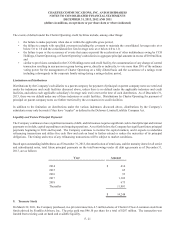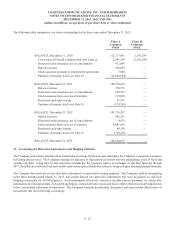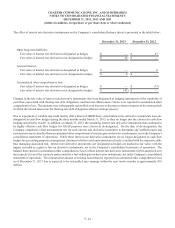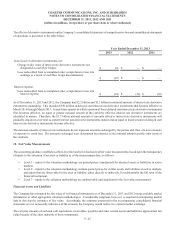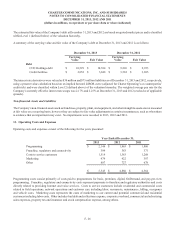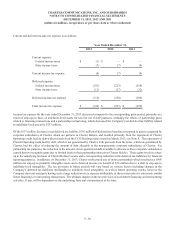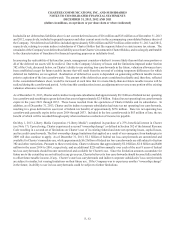Charter 2013 Annual Report Download - page 107
Download and view the complete annual report
Please find page 107 of the 2013 Charter annual report below. You can navigate through the pages in the report by either clicking on the pages listed below, or by using the keyword search tool below to find specific information within the annual report.
CHARTER COMMUNICATIONS, INC. AND SUBSIDIARIES
NOTES TO CONSOLIDATED FINANCIAL STATEMENTS
DECEMBER 31, 2013, 2012 AND 2011
(dollars in millions, except share or per share data or where indicated)
F- 25
The effects of derivative instruments on the Company’s consolidated statements of comprehensive loss and consolidated statements
of operations is presented in the table below.
Year Ended December 31, 2013
2013 2012 2011
Gain (loss) on derivative instruments, net:
Change in fair value of interest rate derivative instruments not
designated as cash flow hedges $ 38$ —$ —
Loss reclassified from accumulated other comprehensive loss into
earnings as a result of cash flow hedge discontinuance
$(27)$ — $ —
Interest expense:
Loss reclassified from accumulated other comprehensive loss into
interest expense $(10)$ (36)$ (39)
As of December 31, 2013 and 2012, the Company had $2.2 billion and $3.1 billion in notional amounts of interest rate derivative
instruments outstanding. This includes $550 million in delayed start interest rate derivative instruments that become effective in
March 2014 through March 2015. In any future quarter in which a portion of these delayed start interest rate derivative instruments
first becomes effective, an equal or greater notional amount of the currently effective interest rate derivative instruments are
scheduled to mature. Therefore, the $1.7 billion notional amount of currently effective interest rate derivative instruments will
gradually step down over time as current interest rate derivative instruments mature and an equal or lesser amount of delayed start
interest rate derivative instruments become effective.
The notional amounts of interest rate instruments do not represent amounts exchanged by the parties and, thus, are not a measure
of exposure to credit loss. The amounts exchanged were determined by reference to the notional amount and the other terms of
the contracts.
12. Fair Value Measurements
The accounting guidance establishes a three-level hierarchy for disclosure of fair value measurements, based upon the transparency
of inputs to the valuation of an asset or liability as of the measurement date, as follows:
• Level 1 – inputs to the valuation methodology are quoted prices (unadjusted) for identical assets or liabilities in active
markets.
• Level 2 – inputs to the valuation methodology include quoted prices for similar assets and liabilities in active markets,
and inputs that are observable for the asset or liability, either directly or indirectly, for substantially the full term of the
financial instrument.
• Level 3 – inputs to the valuation methodology are unobservable and significant to the fair value measurement.
Financial Assets and Liabilities
The Company has estimated the fair value of its financial instruments as of December 31, 2013 and 2012 using available market
information or other appropriate valuation methodologies. Considerable judgment, however, is required in interpreting market
data to develop the estimates of fair value. Accordingly, the estimates presented in the accompanying consolidated financial
statements are not necessarily indicative of the amounts the Company would realize in a current market exchange.
The carrying amounts of cash and cash equivalents, receivables, payables and other current assets and liabilities approximate fair
value because of the short maturity of those instruments.






